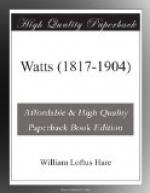In 1877 Watts decided, in conformity with his views on patriotic art, to give his pictures to the nation, and there followed shortly after, in 1881 and 1882, exhibitions of his works in Whitechapel and the Grosvenor Gallery. A leaflet entitled “What should a picture say?” issued with the approval of Watts, in connection with the Whitechapel Exhibition, has a characteristic answer to the question put to him.
“Roughly speaking, a picture must be regarded in the same light as written words. It must speak to the beholder and tell him something.... If a picture is a representation only, then regard it from that point of view only. If it treats of a historical event, consider whether it fairly tells its tale. Then there is another class of picture, that whose purpose is to convey suggestion and idea. You are not to look at that picture as an actual representation of facts, for it comes under the same category of dream visions, aspirations, and we have nothing very distinct except the sentiment. If the painting is bad—the writing, the language of art, it is a pity. The picture is then not so good as it should be, but the thought is there, and the thought is what the artist wanted to express, and it is or should be impressed on the spectator.”
In 1886 his pictures were exhibited in New York, where they created a great sensation; but incidents connected with the exhibition, and criticisms upon it, caused the artist much nervous distress.
[Illustration: Plate III.—Hope
(At the Tate Gallery)
At the first glance it is rather strange that such a picture should bear such a title, but the imagery is perfectly true. The heavens are illuminated by a solitary star, and Hope bends her ear to catch the music from the last remaining string of her almost shattered lyre. The picture was painted in 1885 and given to the nation in 1897. A very fine duplicate is in the possession of Mrs. Rushton.]
It was a peculiar difficulty of his nature which led him to insist, on the occasions of the London and provincial exhibitions of his pictures, that the borrowers were to make all arrangements with his frame-maker, that he should not be called upon to act in any way, and that no personal reference should be introduced. Watts always considered himself a private person; he disliked public functions and fled from them if there were any attempt to draw attention to him. His habits of work were consistent with these unusual traits. At sunrise he was at his easel. During the hot months of summer he was hard at work in his London studio, leaving for the country only for a few weeks during foggy weather.
At the age of sixty-nine Watts married Miss Mary Fraser-Tytler, with whom he journeyed to Egypt, painting there a study of the “Sphinx,” one of the cleverest of his landscapes. Three years after his return, he settled at Limnerslease, Compton, in Surrey, where he took great interest in the attempt to revive industrial art among the rural population.




